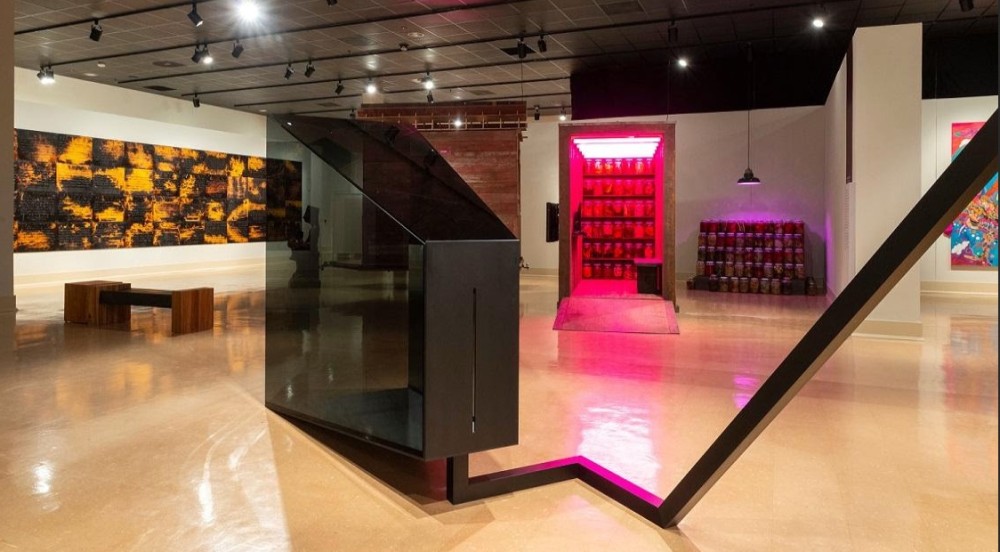A buzzy art exhibit featuring only Black artists, emerging and prominent, grappling with a huge historic moment in Black life is unexpected for the Mississippi Museum of Art (MMA). Presented in collaboration with the Baltimore Museum of Art (BMA), where it will travel afterwards, A Movement in Every Direction: Legacies of the Great Migration is a visual art exploration of one of the most cataclysmic population and cultural shifts in American history.
When more than six million Black Americans left the South for such cities as New York and Philadelphia in the North, Chicago and Detroit in the Midwest, Los Angeles and Oakland in the West—mostly with freedom and safety on their minds from roughly 1915 to 1970—it left a deep imprint. That’s why it was important for the exhibit co-curators Ryan N. Dennis, a Houston native who joined the MMA as Chief Curator and Artistic Director of the Center for Art and Public Exchange in 2020, and Jessica Bell Brown, a Macon, Georgia native who joined BMA in 2019 and assumed duties as Curator and Department Head of Contemporary Art in April, create a broad and nuanced conversation around this historic event. As Black women in mainstream spaces where their presence is still too rare, Dennis and Brown felt a responsibility to put a distinctive stamp on the exhibit that would be both bold and insightful.
“Ideas around the Great Migration are often discussed in a trauma lens,” Dennis noted during the exhibit’s opening weekend in April while also expressing she and Brown’s desire to push past that myopia. “We really wanted to think about the exhibition more expansively [in terms of] where agency and self-determined movement was made more possible for people during this time period.”
Questions they asked the twelve artists, Brown shared, included “What is your connection to the Great Migration? How are migration stories held within your own family stories and personal history?” The result of that introspection is a mix of highly intimate work presented alongside complex ideas of freedom and connection across various mediums of expression that also, in many instances, serve as historic record in and outside the South.
With her minimalist installation The North Star and deeply personal accompanying LEAVE! LEAVE NOW!! video, Portland, Oregon native Carrie Mae Weems, best known for her landmark 1990 The Kitchen Table Series, examines the disappearance of her grandfather, a sharecropper and union organizer from an Arkansas plantation who somehow escaped a lynching to later vanish in Chicago. Acclaimed visual artist and Los Angeles native Mark Bradford’s 500 is a stunning and expansive sixty-paneled mixed media treat doused in intoxicating black and gold paint featuring a “Wanted” ad he found in a 1913 issue of the NAACP’s Crisis magazine calling for “500 Negro families” to settle on “free government lands” with “No ‘Jim Crow’ Laws” in Blackdom, New Mexico.

A photo from one of his family reunions held in nearby Dobbin is the spark that helped Houston native Robert Pruitt, who trained at Texas Southern University, which is known for the great muralist John Biggers, create his brightly colored, Afro-futuristic A Song for Travelers featuring an eclectic blend of Black folks across multiple eras and classes. New Orleans-born Akea Brionne leaned on her family archive to anchor her highly emotional An Ode to Y(ou)’all highlighting that history.
With her Permanent Change of Station piece, Zoë Charlton, who was born on the Eglin Airforce Base in Florida, injects military service into the migration narrative. Meanwhile, Detroit native and Jackson State alum Jamea Richmond-Edwards’ This Water Runs Deep adds a whimsical and colorful twist to her family’s migration from New Orleans to the Motor City. Prominent Chicago artist Theaster Gates Jr’s The Double Wide, with its wood exterior and jars of pickled goods, conjures a warm and familiar South while fellow Chicagoan and Beacon, New York-based artist Torkwase Dyson’s imposing and provocative Way Over There Inside Me (A Festival of Inches) installation in all-black investigates Black spatial history.

Capturing photos of the Georgia and South Carolina landscape from which his paternal family hailed for Let My Testimony Sit Next To Yours, which culminates in a family capsule of sorts a photo of his father guards, served as an important emotional turning point for Maryland-born and based artist Larry W. Cook and his father who shared the journey with him.
“[T]he process,” he revealed, “allowed us to begin to confront a lot of issues we have with each other in terms of him being absent [throughout much of my life].” Learning about his father’s own tenuous relationship with his own absent father, he said, became “an opportunity for us to heal.”
During the exhibition’s grand opening events, the Studio Museum in Harlem’s Thelma Golden told EBONY “this exhibition is so important because of the way in which it not only centers the present through the work of this amazing group of artists, but [also the way in which] it gives this incredible path into the past, and I think, as Carrie Mae Weems just said on this panel, the possibility of what art can do and be for us is so profound and so powerful.”
A Movement in Every Direction: Legacies of the Great Migration, which runs at the Mississippi Museum of Art through September and opens at the Baltimore Museum of Art in October, features programming throughout the summer.
Ronda Racha Penrice is the author of Black American History For Dummies and editor of Cracking The Wire During Black Lives Matter.













